Impact of Entrepreneurship and Small Businesses: A Detailed Report
VerifiedAdded on 2022/12/02
|12
|2549
|80
Report
AI Summary
This report delves into the multifaceted world of entrepreneurship and small business management. It begins by defining entrepreneurship and exploring various venture types, including small businesses, scalable startups, large company ventures, social enterprises, and innovative models, alongside their relation to different entrepreneurial typologies like women and social entrepreneurs. The report then discusses the similarities and differences between these ventures, examining aspects like customer orientation, adaptability to change, and growth potential. Furthermore, the report analyzes statistical data to illustrate the significant impact of micro and small businesses on the UK economy, highlighting their contribution to employment and economic growth. Finally, the report elaborates on the crucial role of startups and small businesses in fostering a robust social economy, emphasizing their contributions to local tax revenue, job creation, and adaptation to local market conditions, and the importance of innovation. The conclusion summarizes the key findings and emphasizes the importance of entrepreneurship and small businesses.

Entrepreneurship and
small business
management.
small business
management.
Paraphrase This Document
Need a fresh take? Get an instant paraphrase of this document with our AI Paraphraser

Table of content
INTRODUCTION...........................................................................................................................2
MAIN BODY...................................................................................................................................3
P1 Different types of entrepreneurial venture and their relation to the typologies of
entrepreneurship........................................................................................................................3
P2 Discuss similarities and differences in entrepreneurial ventures.........................................4
P3 Analyse and interpret data and statistics in order to illustrate the impact of micro and
small business in the economy..................................................................................................6
P4 Elaborate the importance of start-ups and small businesses in the growth of social
economy....................................................................................................................................8
CONCLUSION................................................................................................................................9
REFERENCES..............................................................................................................................10
INTRODUCTION...........................................................................................................................2
MAIN BODY...................................................................................................................................3
P1 Different types of entrepreneurial venture and their relation to the typologies of
entrepreneurship........................................................................................................................3
P2 Discuss similarities and differences in entrepreneurial ventures.........................................4
P3 Analyse and interpret data and statistics in order to illustrate the impact of micro and
small business in the economy..................................................................................................6
P4 Elaborate the importance of start-ups and small businesses in the growth of social
economy....................................................................................................................................8
CONCLUSION................................................................................................................................9
REFERENCES..............................................................................................................................10
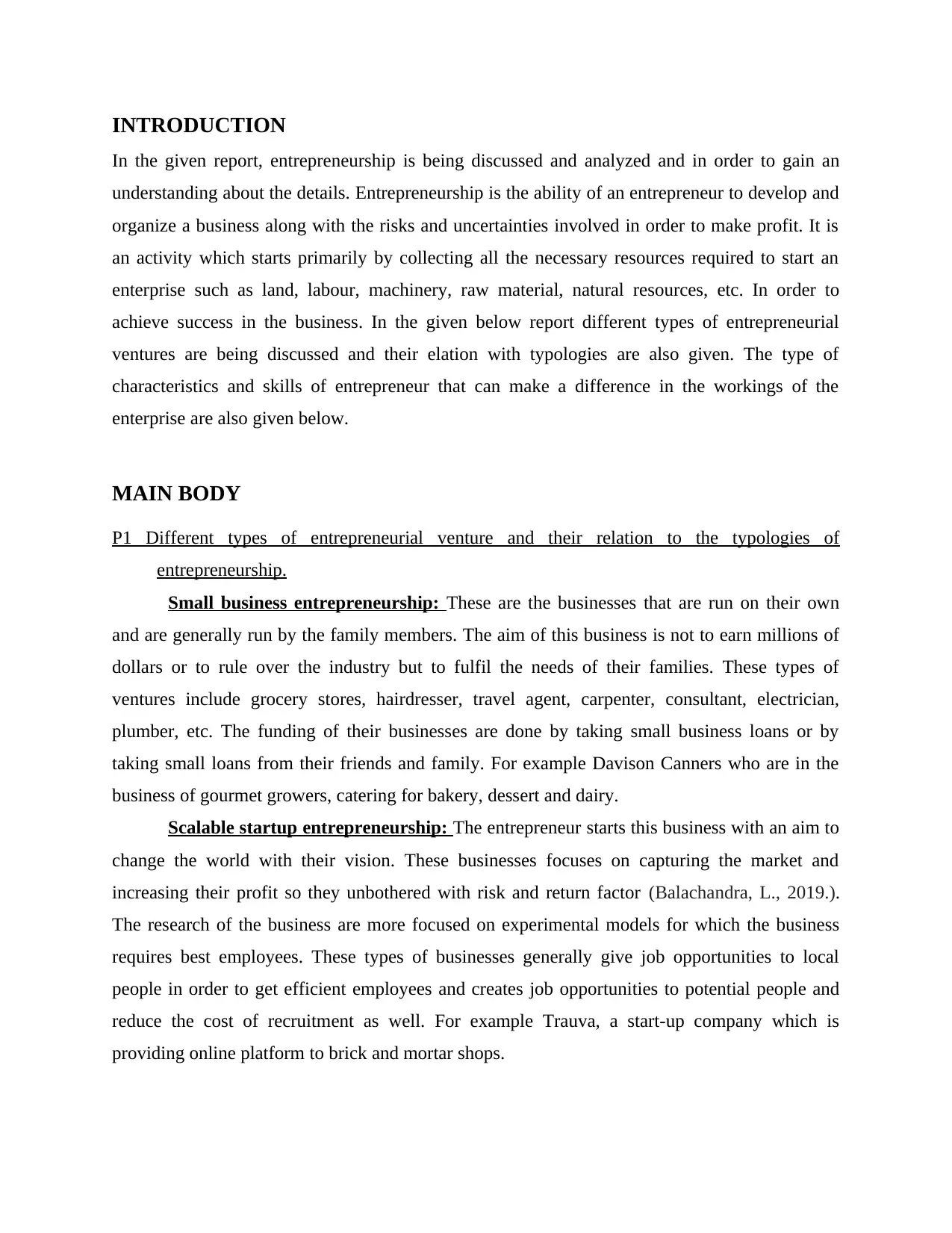
INTRODUCTION
In the given report, entrepreneurship is being discussed and analyzed and in order to gain an
understanding about the details. Entrepreneurship is the ability of an entrepreneur to develop and
organize a business along with the risks and uncertainties involved in order to make profit. It is
an activity which starts primarily by collecting all the necessary resources required to start an
enterprise such as land, labour, machinery, raw material, natural resources, etc. In order to
achieve success in the business. In the given below report different types of entrepreneurial
ventures are being discussed and their elation with typologies are also given. The type of
characteristics and skills of entrepreneur that can make a difference in the workings of the
enterprise are also given below.
MAIN BODY
P1 Different types of entrepreneurial venture and their relation to the typologies of
entrepreneurship.
Small business entrepreneurship: These are the businesses that are run on their own
and are generally run by the family members. The aim of this business is not to earn millions of
dollars or to rule over the industry but to fulfil the needs of their families. These types of
ventures include grocery stores, hairdresser, travel agent, carpenter, consultant, electrician,
plumber, etc. The funding of their businesses are done by taking small business loans or by
taking small loans from their friends and family. For example Davison Canners who are in the
business of gourmet growers, catering for bakery, dessert and dairy.
Scalable startup entrepreneurship: The entrepreneur starts this business with an aim to
change the world with their vision. These businesses focuses on capturing the market and
increasing their profit so they unbothered with risk and return factor (Balachandra, L., 2019.).
The research of the business are more focused on experimental models for which the business
requires best employees. These types of businesses generally give job opportunities to local
people in order to get efficient employees and creates job opportunities to potential people and
reduce the cost of recruitment as well. For example Trauva, a start-up company which is
providing online platform to brick and mortar shops.
In the given report, entrepreneurship is being discussed and analyzed and in order to gain an
understanding about the details. Entrepreneurship is the ability of an entrepreneur to develop and
organize a business along with the risks and uncertainties involved in order to make profit. It is
an activity which starts primarily by collecting all the necessary resources required to start an
enterprise such as land, labour, machinery, raw material, natural resources, etc. In order to
achieve success in the business. In the given below report different types of entrepreneurial
ventures are being discussed and their elation with typologies are also given. The type of
characteristics and skills of entrepreneur that can make a difference in the workings of the
enterprise are also given below.
MAIN BODY
P1 Different types of entrepreneurial venture and their relation to the typologies of
entrepreneurship.
Small business entrepreneurship: These are the businesses that are run on their own
and are generally run by the family members. The aim of this business is not to earn millions of
dollars or to rule over the industry but to fulfil the needs of their families. These types of
ventures include grocery stores, hairdresser, travel agent, carpenter, consultant, electrician,
plumber, etc. The funding of their businesses are done by taking small business loans or by
taking small loans from their friends and family. For example Davison Canners who are in the
business of gourmet growers, catering for bakery, dessert and dairy.
Scalable startup entrepreneurship: The entrepreneur starts this business with an aim to
change the world with their vision. These businesses focuses on capturing the market and
increasing their profit so they unbothered with risk and return factor (Balachandra, L., 2019.).
The research of the business are more focused on experimental models for which the business
requires best employees. These types of businesses generally give job opportunities to local
people in order to get efficient employees and creates job opportunities to potential people and
reduce the cost of recruitment as well. For example Trauva, a start-up company which is
providing online platform to brick and mortar shops.
⊘ This is a preview!⊘
Do you want full access?
Subscribe today to unlock all pages.

Trusted by 1+ million students worldwide
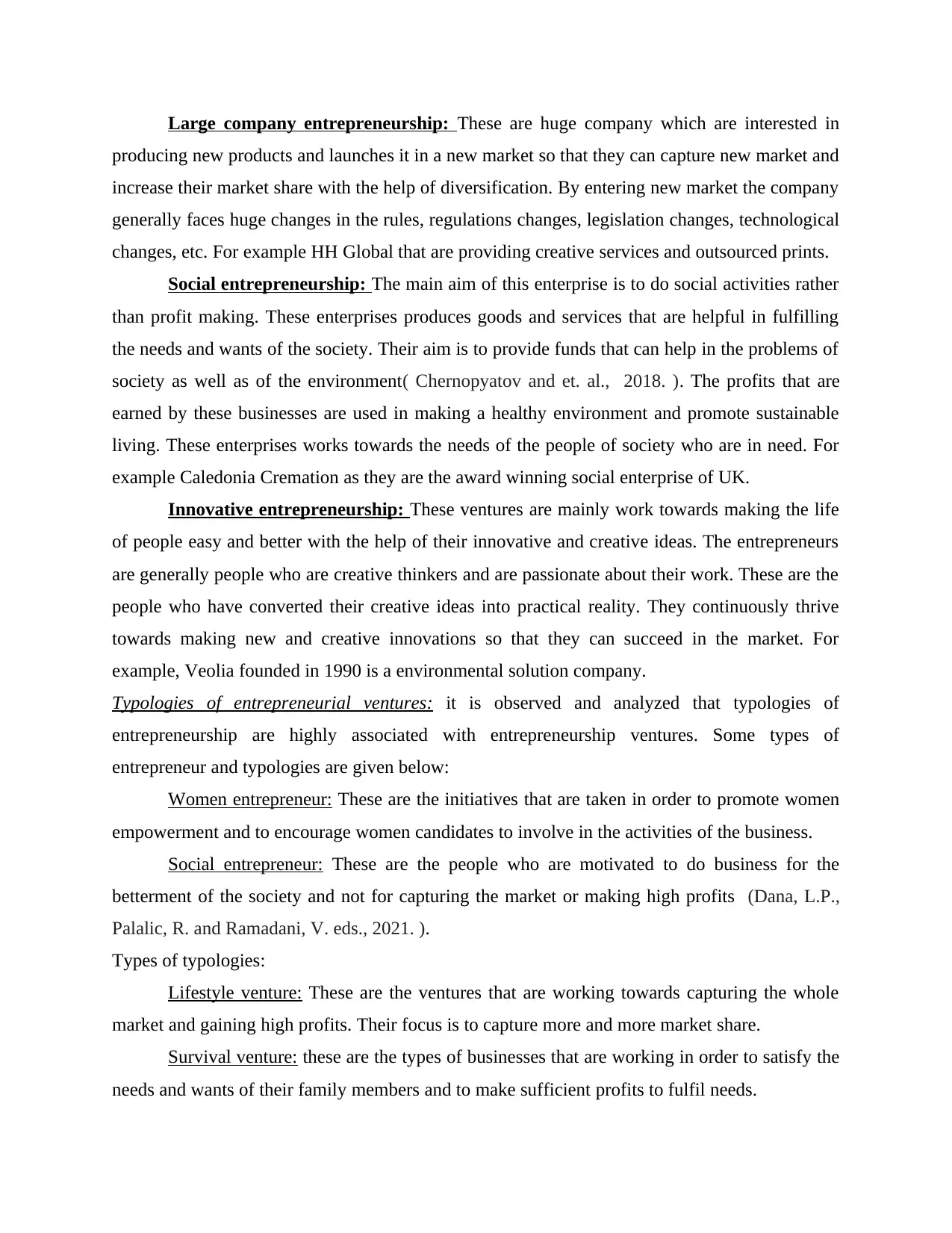
Large company entrepreneurship: These are huge company which are interested in
producing new products and launches it in a new market so that they can capture new market and
increase their market share with the help of diversification. By entering new market the company
generally faces huge changes in the rules, regulations changes, legislation changes, technological
changes, etc. For example HH Global that are providing creative services and outsourced prints.
Social entrepreneurship: The main aim of this enterprise is to do social activities rather
than profit making. These enterprises produces goods and services that are helpful in fulfilling
the needs and wants of the society. Their aim is to provide funds that can help in the problems of
society as well as of the environment( Chernopyatov and et. al., 2018. ). The profits that are
earned by these businesses are used in making a healthy environment and promote sustainable
living. These enterprises works towards the needs of the people of society who are in need. For
example Caledonia Cremation as they are the award winning social enterprise of UK.
Innovative entrepreneurship: These ventures are mainly work towards making the life
of people easy and better with the help of their innovative and creative ideas. The entrepreneurs
are generally people who are creative thinkers and are passionate about their work. These are the
people who have converted their creative ideas into practical reality. They continuously thrive
towards making new and creative innovations so that they can succeed in the market. For
example, Veolia founded in 1990 is a environmental solution company.
Typologies of entrepreneurial ventures: it is observed and analyzed that typologies of
entrepreneurship are highly associated with entrepreneurship ventures. Some types of
entrepreneur and typologies are given below:
Women entrepreneur: These are the initiatives that are taken in order to promote women
empowerment and to encourage women candidates to involve in the activities of the business.
Social entrepreneur: These are the people who are motivated to do business for the
betterment of the society and not for capturing the market or making high profits (Dana, L.P.,
Palalic, R. and Ramadani, V. eds., 2021. ).
Types of typologies:
Lifestyle venture: These are the ventures that are working towards capturing the whole
market and gaining high profits. Their focus is to capture more and more market share.
Survival venture: these are the types of businesses that are working in order to satisfy the
needs and wants of their family members and to make sufficient profits to fulfil needs.
producing new products and launches it in a new market so that they can capture new market and
increase their market share with the help of diversification. By entering new market the company
generally faces huge changes in the rules, regulations changes, legislation changes, technological
changes, etc. For example HH Global that are providing creative services and outsourced prints.
Social entrepreneurship: The main aim of this enterprise is to do social activities rather
than profit making. These enterprises produces goods and services that are helpful in fulfilling
the needs and wants of the society. Their aim is to provide funds that can help in the problems of
society as well as of the environment( Chernopyatov and et. al., 2018. ). The profits that are
earned by these businesses are used in making a healthy environment and promote sustainable
living. These enterprises works towards the needs of the people of society who are in need. For
example Caledonia Cremation as they are the award winning social enterprise of UK.
Innovative entrepreneurship: These ventures are mainly work towards making the life
of people easy and better with the help of their innovative and creative ideas. The entrepreneurs
are generally people who are creative thinkers and are passionate about their work. These are the
people who have converted their creative ideas into practical reality. They continuously thrive
towards making new and creative innovations so that they can succeed in the market. For
example, Veolia founded in 1990 is a environmental solution company.
Typologies of entrepreneurial ventures: it is observed and analyzed that typologies of
entrepreneurship are highly associated with entrepreneurship ventures. Some types of
entrepreneur and typologies are given below:
Women entrepreneur: These are the initiatives that are taken in order to promote women
empowerment and to encourage women candidates to involve in the activities of the business.
Social entrepreneur: These are the people who are motivated to do business for the
betterment of the society and not for capturing the market or making high profits (Dana, L.P.,
Palalic, R. and Ramadani, V. eds., 2021. ).
Types of typologies:
Lifestyle venture: These are the ventures that are working towards capturing the whole
market and gaining high profits. Their focus is to capture more and more market share.
Survival venture: these are the types of businesses that are working in order to satisfy the
needs and wants of their family members and to make sufficient profits to fulfil needs.
Paraphrase This Document
Need a fresh take? Get an instant paraphrase of this document with our AI Paraphraser
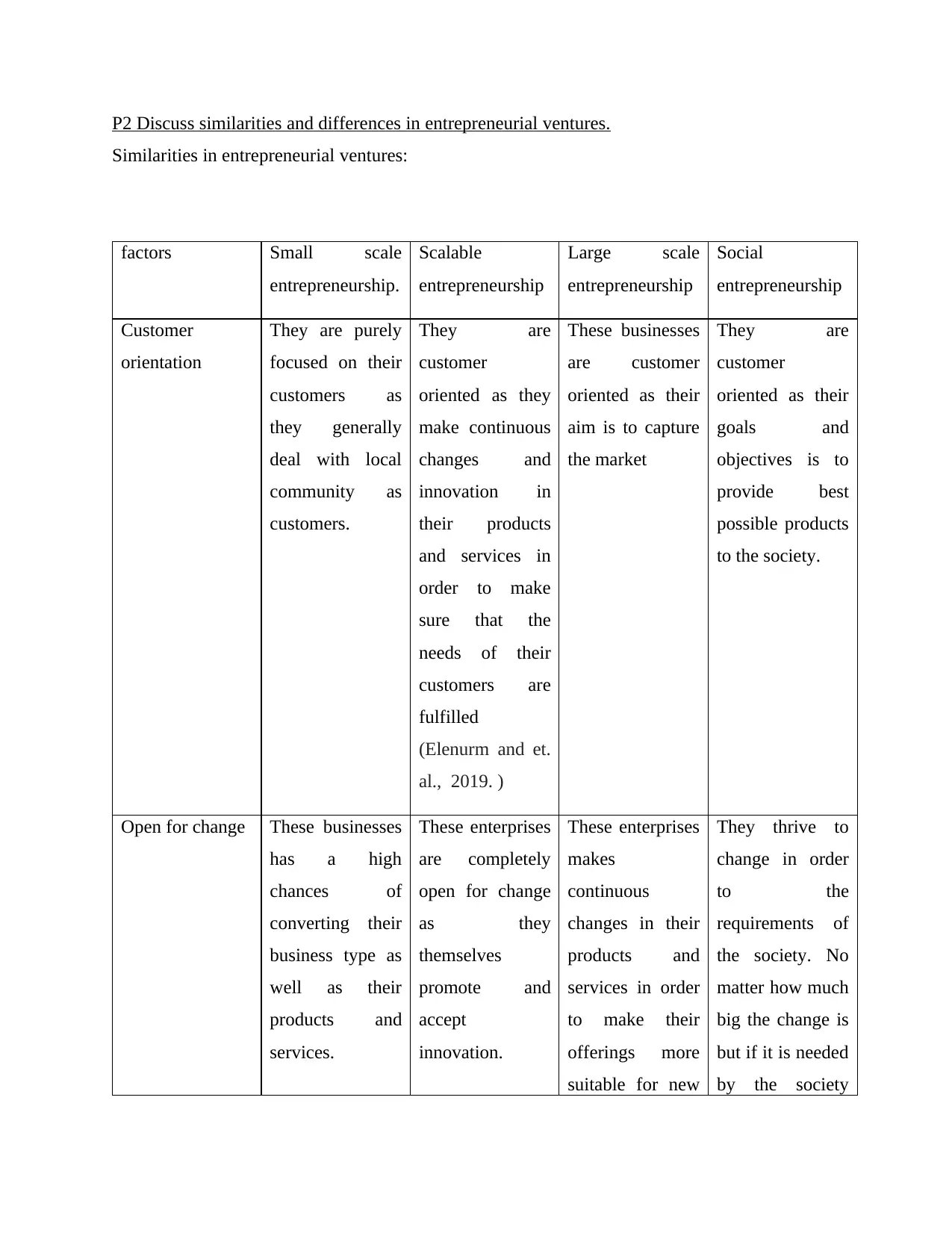
P2 Discuss similarities and differences in entrepreneurial ventures.
Similarities in entrepreneurial ventures:
factors Small scale
entrepreneurship.
Scalable
entrepreneurship
Large scale
entrepreneurship
Social
entrepreneurship
Customer
orientation
They are purely
focused on their
customers as
they generally
deal with local
community as
customers.
They are
customer
oriented as they
make continuous
changes and
innovation in
their products
and services in
order to make
sure that the
needs of their
customers are
fulfilled
(Elenurm and et.
al., 2019. )
These businesses
are customer
oriented as their
aim is to capture
the market
They are
customer
oriented as their
goals and
objectives is to
provide best
possible products
to the society.
Open for change These businesses
has a high
chances of
converting their
business type as
well as their
products and
services.
These enterprises
are completely
open for change
as they
themselves
promote and
accept
innovation.
These enterprises
makes
continuous
changes in their
products and
services in order
to make their
offerings more
suitable for new
They thrive to
change in order
to the
requirements of
the society. No
matter how much
big the change is
but if it is needed
by the society
Similarities in entrepreneurial ventures:
factors Small scale
entrepreneurship.
Scalable
entrepreneurship
Large scale
entrepreneurship
Social
entrepreneurship
Customer
orientation
They are purely
focused on their
customers as
they generally
deal with local
community as
customers.
They are
customer
oriented as they
make continuous
changes and
innovation in
their products
and services in
order to make
sure that the
needs of their
customers are
fulfilled
(Elenurm and et.
al., 2019. )
These businesses
are customer
oriented as their
aim is to capture
the market
They are
customer
oriented as their
goals and
objectives is to
provide best
possible products
to the society.
Open for change These businesses
has a high
chances of
converting their
business type as
well as their
products and
services.
These enterprises
are completely
open for change
as they
themselves
promote and
accept
innovation.
These enterprises
makes
continuous
changes in their
products and
services in order
to make their
offerings more
suitable for new
They thrive to
change in order
to the
requirements of
the society. No
matter how much
big the change is
but if it is needed
by the society
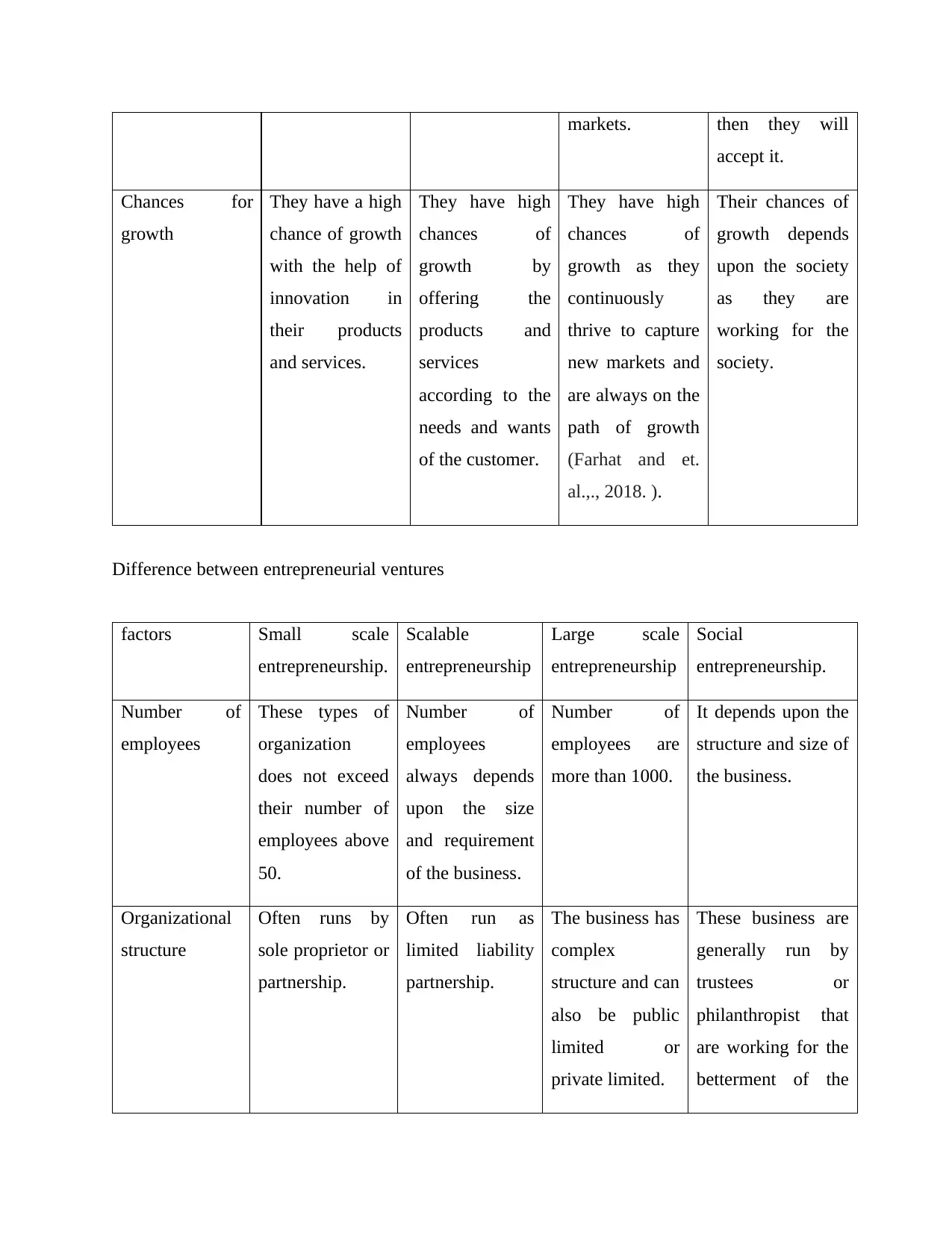
markets. then they will
accept it.
Chances for
growth
They have a high
chance of growth
with the help of
innovation in
their products
and services.
They have high
chances of
growth by
offering the
products and
services
according to the
needs and wants
of the customer.
They have high
chances of
growth as they
continuously
thrive to capture
new markets and
are always on the
path of growth
(Farhat and et.
al.,., 2018. ).
Their chances of
growth depends
upon the society
as they are
working for the
society.
Difference between entrepreneurial ventures
factors Small scale
entrepreneurship.
Scalable
entrepreneurship
Large scale
entrepreneurship
Social
entrepreneurship.
Number of
employees
These types of
organization
does not exceed
their number of
employees above
50.
Number of
employees
always depends
upon the size
and requirement
of the business.
Number of
employees are
more than 1000.
It depends upon the
structure and size of
the business.
Organizational
structure
Often runs by
sole proprietor or
partnership.
Often run as
limited liability
partnership.
The business has
complex
structure and can
also be public
limited or
private limited.
These business are
generally run by
trustees or
philanthropist that
are working for the
betterment of the
accept it.
Chances for
growth
They have a high
chance of growth
with the help of
innovation in
their products
and services.
They have high
chances of
growth by
offering the
products and
services
according to the
needs and wants
of the customer.
They have high
chances of
growth as they
continuously
thrive to capture
new markets and
are always on the
path of growth
(Farhat and et.
al.,., 2018. ).
Their chances of
growth depends
upon the society
as they are
working for the
society.
Difference between entrepreneurial ventures
factors Small scale
entrepreneurship.
Scalable
entrepreneurship
Large scale
entrepreneurship
Social
entrepreneurship.
Number of
employees
These types of
organization
does not exceed
their number of
employees above
50.
Number of
employees
always depends
upon the size
and requirement
of the business.
Number of
employees are
more than 1000.
It depends upon the
structure and size of
the business.
Organizational
structure
Often runs by
sole proprietor or
partnership.
Often run as
limited liability
partnership.
The business has
complex
structure and can
also be public
limited or
private limited.
These business are
generally run by
trustees or
philanthropist that
are working for the
betterment of the
⊘ This is a preview!⊘
Do you want full access?
Subscribe today to unlock all pages.

Trusted by 1+ million students worldwide
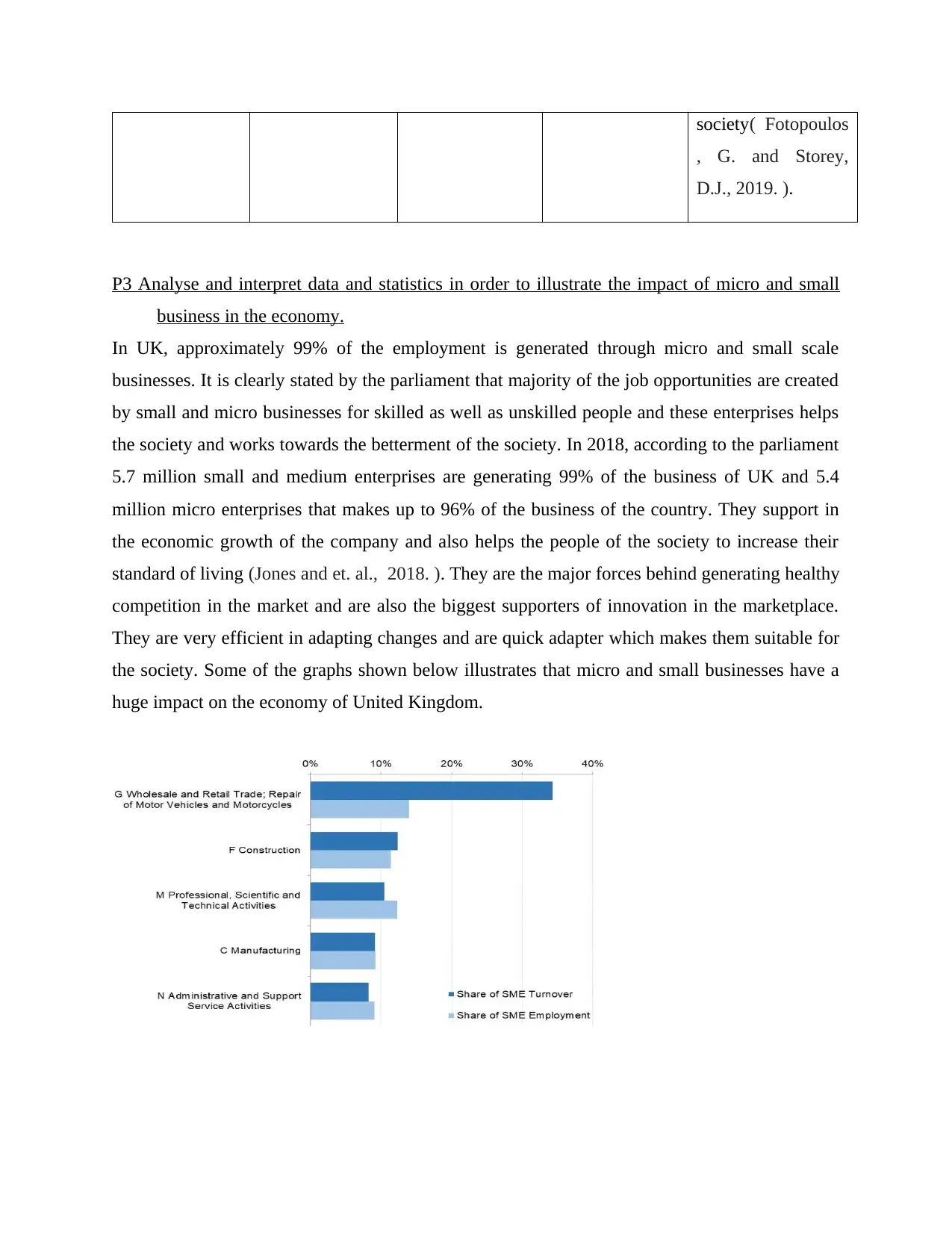
society( Fotopoulos
, G. and Storey,
D.J., 2019. ).
P3 Analyse and interpret data and statistics in order to illustrate the impact of micro and small
business in the economy.
In UK, approximately 99% of the employment is generated through micro and small scale
businesses. It is clearly stated by the parliament that majority of the job opportunities are created
by small and micro businesses for skilled as well as unskilled people and these enterprises helps
the society and works towards the betterment of the society. In 2018, according to the parliament
5.7 million small and medium enterprises are generating 99% of the business of UK and 5.4
million micro enterprises that makes up to 96% of the business of the country. They support in
the economic growth of the company and also helps the people of the society to increase their
standard of living (Jones and et. al., 2018. ). They are the major forces behind generating healthy
competition in the market and are also the biggest supporters of innovation in the marketplace.
They are very efficient in adapting changes and are quick adapter which makes them suitable for
the society. Some of the graphs shown below illustrates that micro and small businesses have a
huge impact on the economy of United Kingdom.
, G. and Storey,
D.J., 2019. ).
P3 Analyse and interpret data and statistics in order to illustrate the impact of micro and small
business in the economy.
In UK, approximately 99% of the employment is generated through micro and small scale
businesses. It is clearly stated by the parliament that majority of the job opportunities are created
by small and micro businesses for skilled as well as unskilled people and these enterprises helps
the society and works towards the betterment of the society. In 2018, according to the parliament
5.7 million small and medium enterprises are generating 99% of the business of UK and 5.4
million micro enterprises that makes up to 96% of the business of the country. They support in
the economic growth of the company and also helps the people of the society to increase their
standard of living (Jones and et. al., 2018. ). They are the major forces behind generating healthy
competition in the market and are also the biggest supporters of innovation in the marketplace.
They are very efficient in adapting changes and are quick adapter which makes them suitable for
the society. Some of the graphs shown below illustrates that micro and small businesses have a
huge impact on the economy of United Kingdom.
Paraphrase This Document
Need a fresh take? Get an instant paraphrase of this document with our AI Paraphraser
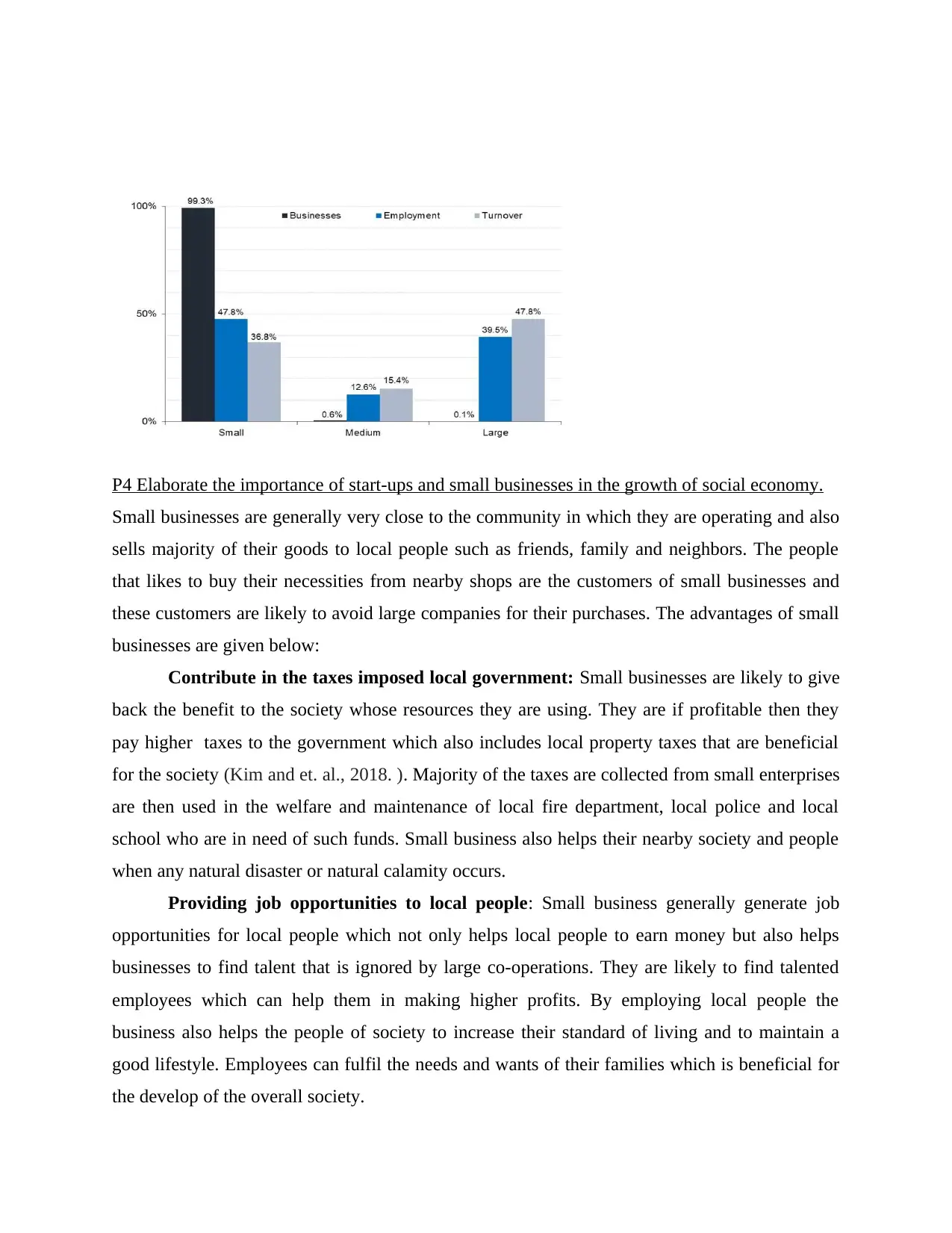
P4 Elaborate the importance of start-ups and small businesses in the growth of social economy.
Small businesses are generally very close to the community in which they are operating and also
sells majority of their goods to local people such as friends, family and neighbors. The people
that likes to buy their necessities from nearby shops are the customers of small businesses and
these customers are likely to avoid large companies for their purchases. The advantages of small
businesses are given below:
Contribute in the taxes imposed local government: Small businesses are likely to give
back the benefit to the society whose resources they are using. They are if profitable then they
pay higher taxes to the government which also includes local property taxes that are beneficial
for the society (Kim and et. al., 2018. ). Majority of the taxes are collected from small enterprises
are then used in the welfare and maintenance of local fire department, local police and local
school who are in need of such funds. Small business also helps their nearby society and people
when any natural disaster or natural calamity occurs.
Providing job opportunities to local people: Small business generally generate job
opportunities for local people which not only helps local people to earn money but also helps
businesses to find talent that is ignored by large co-operations. They are likely to find talented
employees which can help them in making higher profits. By employing local people the
business also helps the people of society to increase their standard of living and to maintain a
good lifestyle. Employees can fulfil the needs and wants of their families which is beneficial for
the develop of the overall society.
Small businesses are generally very close to the community in which they are operating and also
sells majority of their goods to local people such as friends, family and neighbors. The people
that likes to buy their necessities from nearby shops are the customers of small businesses and
these customers are likely to avoid large companies for their purchases. The advantages of small
businesses are given below:
Contribute in the taxes imposed local government: Small businesses are likely to give
back the benefit to the society whose resources they are using. They are if profitable then they
pay higher taxes to the government which also includes local property taxes that are beneficial
for the society (Kim and et. al., 2018. ). Majority of the taxes are collected from small enterprises
are then used in the welfare and maintenance of local fire department, local police and local
school who are in need of such funds. Small business also helps their nearby society and people
when any natural disaster or natural calamity occurs.
Providing job opportunities to local people: Small business generally generate job
opportunities for local people which not only helps local people to earn money but also helps
businesses to find talent that is ignored by large co-operations. They are likely to find talented
employees which can help them in making higher profits. By employing local people the
business also helps the people of society to increase their standard of living and to maintain a
good lifestyle. Employees can fulfil the needs and wants of their families which is beneficial for
the develop of the overall society.

Adapting to local climate: The small or local businesses are aware of the climatic
conditions of a society so it is more likely that they will respond to those climatic changes more
quickly as compared to those who are not aware of climatic situation (Kreiser and et. al., 2021. ).
Start-up are the businesses that are initiated in order to convert any creative idea into practical
reality. These businesses are very important for the society as they are the driving forces of
innovation and economy as well. Some of the advantages of start-ups are given below:
Innovation: they are the main forces that are helping the society in economic
development. The small businesses are playing a major role in providing updated technology to
the society and they also helps the society to adapt with those technological changes that helps
them in living a better life and helps them to raise their standard of living.
Creating new economic dynamics in the economy: Dynamic economy is an essential
part of the economy as they promote healthy competition in the market and will also ensures that
they ways of doing business are in the favour of the betterment of the society. Healthy
competition is very necessary in order to prevent market from unhealthy practices.
Respecting new ideas of young generation: They generally accepts new ideas that they
seem beneficial for their businesses. They are risk takers and also helps young generation to
bring their ideas into reality. The main concept of startups is to implement the innovative ideas
of young generation into actual market place and gain profits from these ventures and achieve
success.
conditions of a society so it is more likely that they will respond to those climatic changes more
quickly as compared to those who are not aware of climatic situation (Kreiser and et. al., 2021. ).
Start-up are the businesses that are initiated in order to convert any creative idea into practical
reality. These businesses are very important for the society as they are the driving forces of
innovation and economy as well. Some of the advantages of start-ups are given below:
Innovation: they are the main forces that are helping the society in economic
development. The small businesses are playing a major role in providing updated technology to
the society and they also helps the society to adapt with those technological changes that helps
them in living a better life and helps them to raise their standard of living.
Creating new economic dynamics in the economy: Dynamic economy is an essential
part of the economy as they promote healthy competition in the market and will also ensures that
they ways of doing business are in the favour of the betterment of the society. Healthy
competition is very necessary in order to prevent market from unhealthy practices.
Respecting new ideas of young generation: They generally accepts new ideas that they
seem beneficial for their businesses. They are risk takers and also helps young generation to
bring their ideas into reality. The main concept of startups is to implement the innovative ideas
of young generation into actual market place and gain profits from these ventures and achieve
success.
⊘ This is a preview!⊘
Do you want full access?
Subscribe today to unlock all pages.

Trusted by 1+ million students worldwide

CONCLUSION
From the above report is it analyzed and concluded that enterprise and small businesses are an
essential part of the economy and no economy can have growth without them. They are essential
for the economy as they generate high amount of employment opportunities and also they
generate the majority of the business for the economy of a country.
From the above report is it analyzed and concluded that enterprise and small businesses are an
essential part of the economy and no economy can have growth without them. They are essential
for the economy as they generate high amount of employment opportunities and also they
generate the majority of the business for the economy of a country.
Paraphrase This Document
Need a fresh take? Get an instant paraphrase of this document with our AI Paraphraser
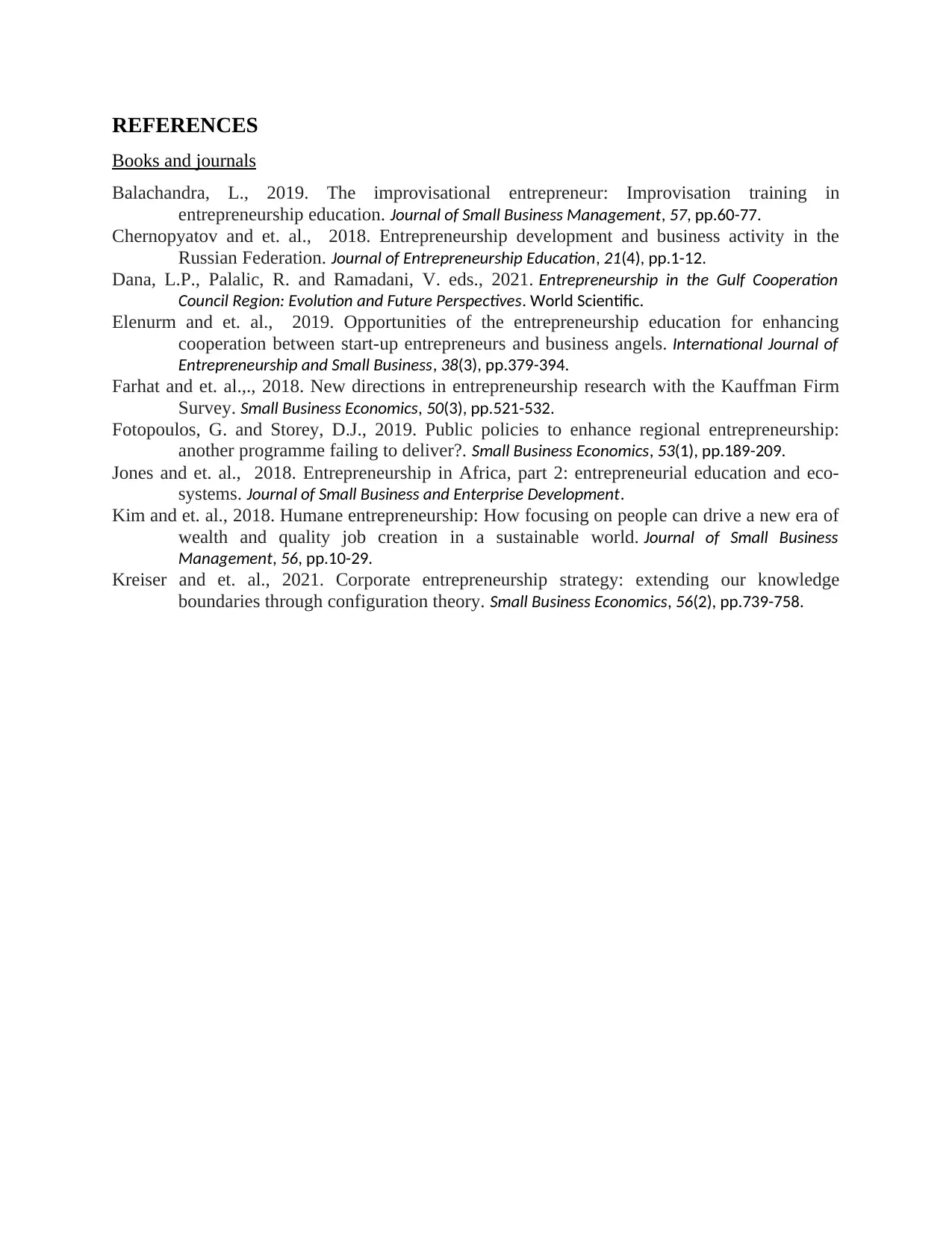
REFERENCES
Books and journals
Balachandra, L., 2019. The improvisational entrepreneur: Improvisation training in
entrepreneurship education. Journal of Small Business Management, 57, pp.60-77.
Chernopyatov and et. al., 2018. Entrepreneurship development and business activity in the
Russian Federation. Journal of Entrepreneurship Education, 21(4), pp.1-12.
Dana, L.P., Palalic, R. and Ramadani, V. eds., 2021. Entrepreneurship in the Gulf Cooperation
Council Region: Evolution and Future Perspectives. World Scientific.
Elenurm and et. al., 2019. Opportunities of the entrepreneurship education for enhancing
cooperation between start-up entrepreneurs and business angels. International Journal of
Entrepreneurship and Small Business, 38(3), pp.379-394.
Farhat and et. al.,., 2018. New directions in entrepreneurship research with the Kauffman Firm
Survey. Small Business Economics, 50(3), pp.521-532.
Fotopoulos, G. and Storey, D.J., 2019. Public policies to enhance regional entrepreneurship:
another programme failing to deliver?. Small Business Economics, 53(1), pp.189-209.
Jones and et. al., 2018. Entrepreneurship in Africa, part 2: entrepreneurial education and eco-
systems. Journal of Small Business and Enterprise Development.
Kim and et. al., 2018. Humane entrepreneurship: How focusing on people can drive a new era of
wealth and quality job creation in a sustainable world. Journal of Small Business
Management, 56, pp.10-29.
Kreiser and et. al., 2021. Corporate entrepreneurship strategy: extending our knowledge
boundaries through configuration theory. Small Business Economics, 56(2), pp.739-758.
Books and journals
Balachandra, L., 2019. The improvisational entrepreneur: Improvisation training in
entrepreneurship education. Journal of Small Business Management, 57, pp.60-77.
Chernopyatov and et. al., 2018. Entrepreneurship development and business activity in the
Russian Federation. Journal of Entrepreneurship Education, 21(4), pp.1-12.
Dana, L.P., Palalic, R. and Ramadani, V. eds., 2021. Entrepreneurship in the Gulf Cooperation
Council Region: Evolution and Future Perspectives. World Scientific.
Elenurm and et. al., 2019. Opportunities of the entrepreneurship education for enhancing
cooperation between start-up entrepreneurs and business angels. International Journal of
Entrepreneurship and Small Business, 38(3), pp.379-394.
Farhat and et. al.,., 2018. New directions in entrepreneurship research with the Kauffman Firm
Survey. Small Business Economics, 50(3), pp.521-532.
Fotopoulos, G. and Storey, D.J., 2019. Public policies to enhance regional entrepreneurship:
another programme failing to deliver?. Small Business Economics, 53(1), pp.189-209.
Jones and et. al., 2018. Entrepreneurship in Africa, part 2: entrepreneurial education and eco-
systems. Journal of Small Business and Enterprise Development.
Kim and et. al., 2018. Humane entrepreneurship: How focusing on people can drive a new era of
wealth and quality job creation in a sustainable world. Journal of Small Business
Management, 56, pp.10-29.
Kreiser and et. al., 2021. Corporate entrepreneurship strategy: extending our knowledge
boundaries through configuration theory. Small Business Economics, 56(2), pp.739-758.

⊘ This is a preview!⊘
Do you want full access?
Subscribe today to unlock all pages.

Trusted by 1+ million students worldwide
1 out of 12
Related Documents
Your All-in-One AI-Powered Toolkit for Academic Success.
+13062052269
info@desklib.com
Available 24*7 on WhatsApp / Email
![[object Object]](/_next/static/media/star-bottom.7253800d.svg)
Unlock your academic potential
Copyright © 2020–2025 A2Z Services. All Rights Reserved. Developed and managed by ZUCOL.





